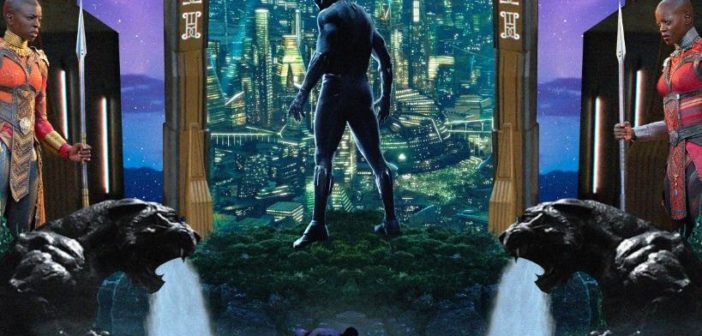With the amount of hype that surrounds “Black Panther,” it is imperative that The Lions Pride’ Newspaper break down the essential parts of the movie.
The excitement that “Black Panther” has garnered has been due in part to the progression it gives to the entire Marvel Cinematic Universe, but also to its stellar casting, unique themes, and great cinematography.
“Black Panther” is the 18th film in Marvel Cinematic franchise and picks up at the end of the events of “Captain America: Civil War.” After the death of his father T’Challa (Chadwick Boseman) finds himself taking on the mantle of Black Panther and King of Wakanda.
The film glances at the traditions of the people of Wakanda, while addressing their lifestyles as the world around them begins to change. Conflict looms as characters both old and new bring the world to Wakanda’s doorstep infringing on a false sense of security the nation has always known.
One of the quintessential components of this movie has been the casting options made, as a little over 95 percent of the film cast was black. Two of the Caucasian faces that reprised roles in this film, has been Andy Serkis (Ulysses Klaue) and Martin Freeman (Everett K. Ross), who have both been coined “The Tolkien Brothers” for their roles in the “Lord of the Rings” franchise while satirizing their token positions. Both characters are worth their weight in gold for their roles, as they shine in their own unique ways, not as plot advancements but as irrevocable parts of the collective world Marvel created.
Chadwick Bozeman has shown himself as someone to watch for in the future as his presence filled every scene with a presence that implored the audience to listen. Whether portraying a king, a broken son, brother or a human being Bozeman lit the theater with vitality second to none.
Supporting him in his role were some unique yet common faces which included Angela Bassett and Forest Whitaker, who in their own right have impressed audiences for years.
However, the most shocking performances by far have been from Letitia Wright, (Nakia sister to T’Challa) most recognized for her role in “Black Mirror” Season 4-episode “Black Museum,” and Danai Gurira, (Okoye general to the Wakandan Army) notable for her role in “The Walking Dead” Franchise. Both actors shined in every scene that they were in, however their roles in the movie gave life to the big screen for varying reasons. Nakia did not accept the role of sister to the king and portray a weak female by any means, her character was strong intelligent and crafted as an inspiration to females everywhere.
Similarly, Gurira continues her portrayal of a strong female as she has done in “The Walking Dead” and shows herself to be commanding, endearing and charming for every scene.
Equally important to the characters was the protagonist, Michael B. Jordan (Killmonger) who represented the first villain in years to enter the MCU, and be properly fleshed out. Jordan impresses as his range is incredible but his cause is believable and something that the audience has identified with on several levels. Several critics have complained that Killmonger as a character was not seen on screen nearly enough, however, for the entire film to work as well as it has there could not be constant conflict on screen.
The direction of the film could not be any better as Kevin Feige (producer of the Marvel Cinematic Universe) has not failed to disappoint audiences with his style and vision for the world created.
Director and writer Ryan Coogler has brought to the MCU his touch and flare that is most appreciated from earlier films such as Creed and Fruitvale Station. Coincidentally, both of his previous films involved working with Michael B. Jordan and for the third time audiences are in awe of this duo.
The film utilizes a generous amount of defamiliarization to mask several underlying themes that shakes the screenplay at its core. Defamiliarization is an art form introduced by Victor Shklovsky that causes persons to look at something again, as human’s everyday perceptions (due in part to familiarity) have grown accustomed to some experiences.
Beyond the computer graphics of a stunning society influenced but unchanged by advanced technology are themes that resonate beyond the end credits. Community is one such theme that perpetuates continually, its breathed into the body of the plot as characters stick together and carry out traditions that would seem archaic to others. Even to the detriment of the protagonist the film persists on giving what’s necessary to give meaning to every scene.
In a strategic move as well Marvel that released this film in the middle of Black History Month, which has given a message to the film industry. It emphasizes the point that it’s possible to portray African culture, without Americanizing it. Far from tradition as well the film uses several untraditional film locations such as Oakland California and South Korea as film locations, which emphasize a World Community theme.
Even more remarkable is the way that the film galvanizes audiences of each ethnicity by including them in its message of advancing the world and not self-progression. Though Black Panther comes off as overly ambitious with the theme of global advancement, through a character like T’Challa we understand that is possible for one man to make a difference.
Scene transitions, action sequences and beautiful landscapes marked Black Panther a cinematographic masterpiece. The CGI (Computer Generated Images), was not as seamless as some may have hoped for, however most scenes were shot and performed with incredible care. Fight sequences used the technique of shaky camera only when necessary and provided the movie with a layer of hyperrealism that continued to draw the audience in frame by frame.
The world brought to the audience can be juxtaposed against those brought in James Cameron’s “Avatar,” as Wakanda is bright where it needs to be and dark when it wants to be and is backlit by an almost raven-tainted sky.
Tying together the visual display of the movie was an ear-pleasing soundtrack produced by 12-time Grammy winner Kendrick Lamar who leaves nothing in the studio as his unique work shines brightly. Swelling the hearts of audiences was an impressive score, produced by Ludwig Goransson, that is unlike any ever in a Marvel movie. Last but not least was the spoken word piece by Gil Scott Heron titled “The Revolution” will not be televised that was released in 1971 but still holds significant relevance in today’s social climate.
It’s important to note that the plot development holds strong, as audiences are drawn toward understanding the frustrations of the son turned king T’Challa and the ever-growing problems he inherits. The film brings new meaning to the adage, “The sins of the father fall onto the son.” T’Challa and his people have grown in isolation for so long, never knowing the extent of what they have been shielded from as they grow. Marvel uses T’Challa’s predicament as its springboard to Infinity Wars where the entire world will be affected.
“Black Panther” does not feel like the 18th film in a series. It stands on its own paws, as an origin story and progeny to so many other films like “Captain America” and adds depth to arcs like “Ultron” as fans learn more about the mysterious metal, Vibranium.
The characters have a chemistry that cannot be glanced over or overemphasized, alone they are strong but together they explode the silver screen with their collective talents.
So was it worth the hype? Certainly! The combination of all the efforts of the cinematographers and actors give credence to the hype and publicity the film gained in the weeks before its release. At present movie aggregate Rotten Tomatoes has certified the film as “Fresh” with a 97 out 100 percent rating as of 2.19.18. Additionally, the film has made 201.8 Million in box offices so far in its opening weekend which is supplemented with an additional day due to the Presidents Day Holiday.
No doubt, “Black Panther” has given an incredible amount of ethos to Marvel’s franchise and will continue to give audiences topics for discussion.
For the video review on “Black Panther,” find us on YouTube at The Lions’ Pride Newspaper.





